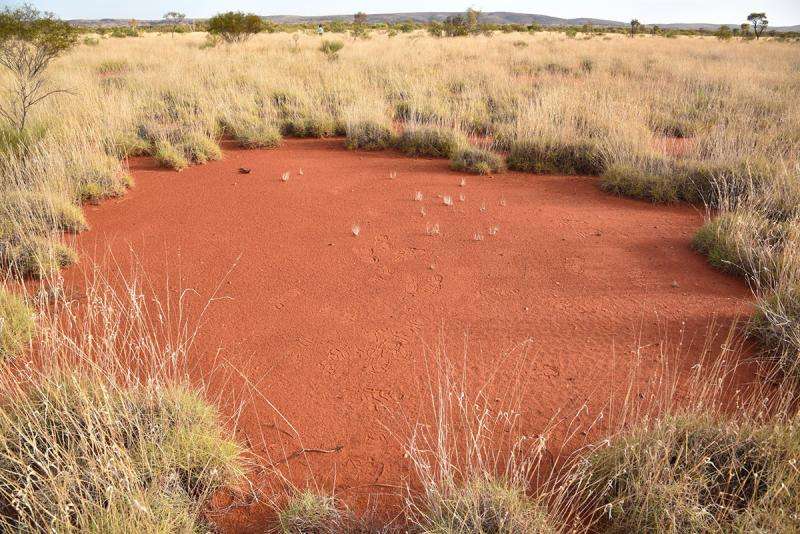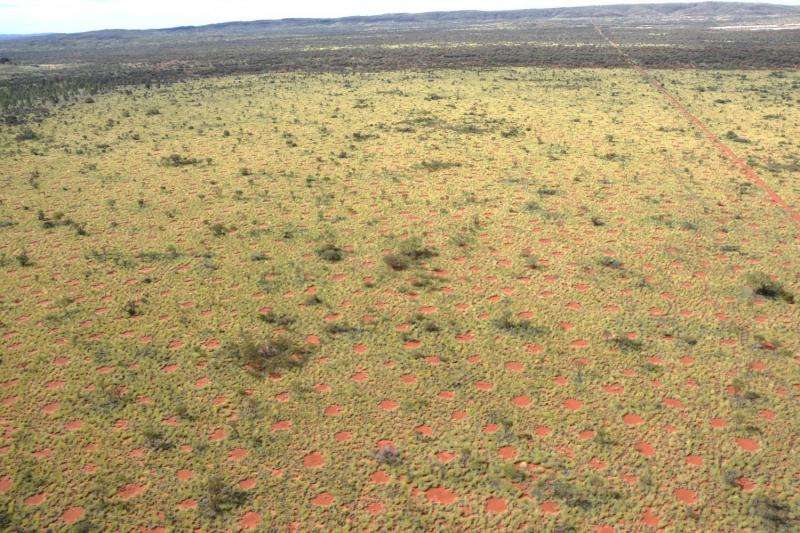March 15, 2016 report
Fairy circles found in Australian outback

(Phys.org)—A small team of researchers from Germany, Israel and Australia has confirmed that fairy circles exist in a part of the Australian outback. In their paper published in Proceedings of the National Academy of Sciences, the researchers describe not only evidence for fairy circles in Australia, but evidence of why they form.
Prior to this new discovery, fairy circles have only ever been seen in Namibia, Africa, where they have elicited explanations for their existence from various people for hundreds, if not thousands of years. More recently, scientists have been split between two explanations—that termites are responsible for their formation or that they are self forming due to the way grasses pull moisture from the soil.
Fairy circles are bald patches in fields of grass and are evenly spaced over a large area in a hexagonal pattern. Each patch is typically circular with a diameter of several feet. Because the ground is red, the patches stand out against the green and brown grass, particularly when seen from an airplane. In this new effort, one of the members of the research team, Stephan Getzin was part of another team that published a paper supporting the self-forming theory—that paper came to the attention of Bronwyn Bell, an environmental manager for a mining company who noticed a resemblance between pictures in the paper and patches in areas near the mines where she worked. She contacted Getzin, who promptly organized a team to investigate.
The researchers studied the circles both on the ground and from the air, and determined that despite drastic differences in soil makeup, the circles appeared to be nearly identical to those in Africa. The finding has led credence to the natural formation theory because termites are sparse in the area where the circles exist in Australia.

The researchers suggest the circles form due to competition for water in the arid area—dominant plants pull more water from the soil than less dominant plants eventually leading to the death of weaker plants and leaving bare earth behind. When it does rain, the water on the surface drains to plants around the rim. In Africa, where the soil is sandier, the water is pulled from the circle underneath by strong rooted grass plants.
More information: Stephan Getzin et al. Discovery of fairy circles in Australia supports self-organization theory, Proceedings of the National Academy of Sciences (2016). DOI: 10.1073/pnas.1522130113
Abstract
Vegetation gap patterns in arid grasslands, such as the "fairy circles" of Namibia, are one of nature's greatest mysteries and subject to a lively debate on their origin. They are characterized by small-scale hexagonal ordering of circular bare-soil gaps that persists uniformly in the landscape scale to form a homogeneous distribution. Pattern-formation theory predicts that such highly ordered gap patterns should be found also in other water-limited systems across the globe, even if the mechanisms of their formation are different. Here we report that so far unknown fairy circles with the same spatial structure exist 10,000 km away from Namibia in the remote outback of Australia. Combining fieldwork, remote sensing, spatial pattern analysis, and process-based mathematical modeling, we demonstrate that these patterns emerge by self-organization, with no correlation with termite activity; the driving mechanism is a positive biomass–water feedback associated with water runoff and biomass-dependent infiltration rates. The remarkable match between the patterns of Australian and Namibian fairy circles and model results indicate that both patterns emerge from a nonuniform stationary instability, supporting a central universality principle of pattern-formation theory. Applied to the context of dryland vegetation, this principle predicts that different systems that go through the same instability type will show similar vegetation patterns even if the feedback mechanisms and resulting soil–water distributions are different, as we indeed found by comparing the Australian and the Namibian fairy-circle ecosystems. These results suggest that biomass–water feedbacks and resultant vegetation gap patterns are likely more common in remote drylands than is currently known.
Journal information: Proceedings of the National Academy of Sciences
© 2016 Phys.org




















